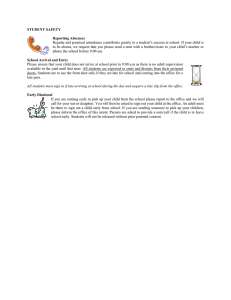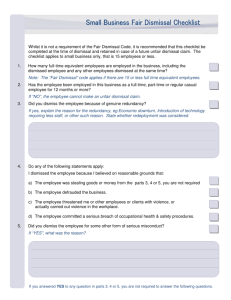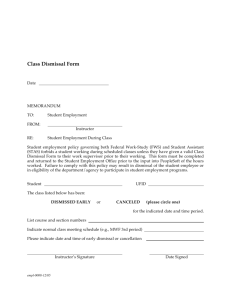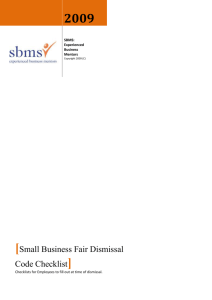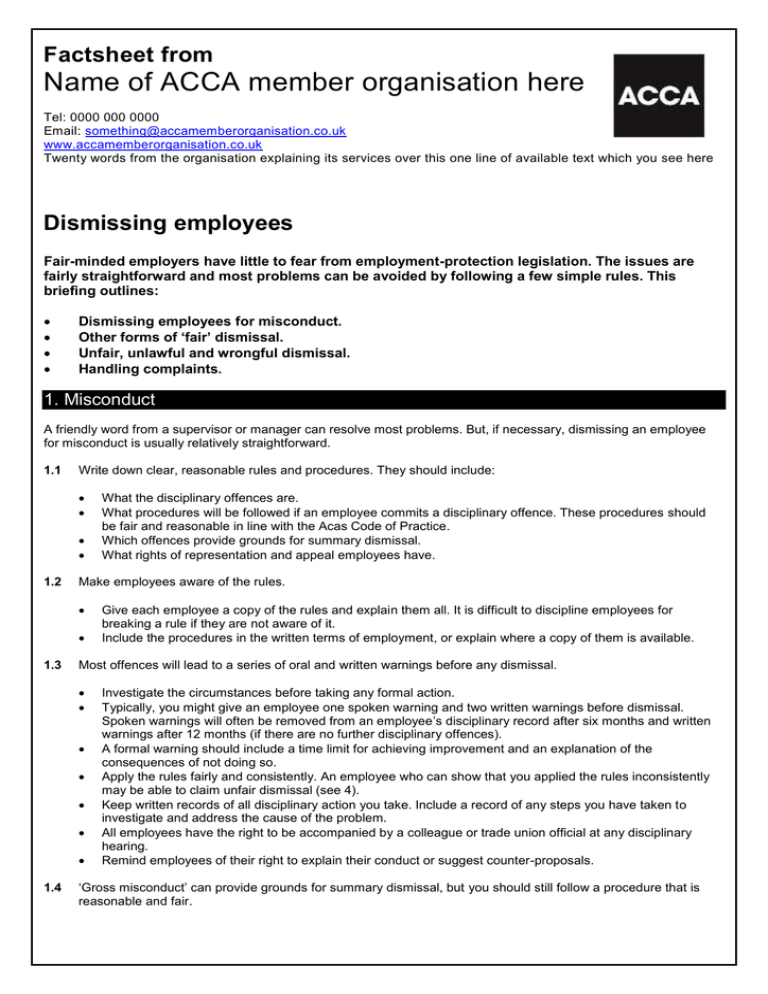
Factsheet from
Name of ACCA member organisation here
Tel: 0000 000 0000
Email: something@accamemberorganisation.co.uk
www.accamemberorganisation.co.uk
Twenty words from the organisation explaining its services over this one line of available text which you see here
Dismissing employees
Fair-minded employers have little to fear from employment-protection legislation. The issues are
fairly straightforward and most problems can be avoided by following a few simple rules. This
briefing outlines:
Dismissing employees for misconduct.
Other forms of ‘fair’ dismissal.
Unfair, unlawful and wrongful dismissal.
Handling complaints.
1. Misconduct
A friendly word from a supervisor or manager can resolve most problems. But, if necessary, dismissing an employee
for misconduct is usually relatively straightforward.
1.1
Write down clear, reasonable rules and procedures. They should include:
1.2
Make employees aware of the rules.
1.3
Give each employee a copy of the rules and explain them all. It is difficult to discipline employees for
breaking a rule if they are not aware of it.
Include the procedures in the written terms of employment, or explain where a copy of them is available.
Most offences will lead to a series of oral and written warnings before any dismissal.
1.4
What the disciplinary offences are.
What procedures will be followed if an employee commits a disciplinary offence. These procedures should
be fair and reasonable in line with the Acas Code of Practice.
Which offences provide grounds for summary dismissal.
What rights of representation and appeal employees have.
Investigate the circumstances before taking any formal action.
Typically, you might give an employee one spoken warning and two written warnings before dismissal.
Spoken warnings will often be removed from an employee’s disciplinary record after six months and written
warnings after 12 months (if there are no further disciplinary offences).
A formal warning should include a time limit for achieving improvement and an explanation of the
consequences of not doing so.
Apply the rules fairly and consistently. An employee who can show that you applied the rules inconsistently
may be able to claim unfair dismissal (see 4).
Keep written records of all disciplinary action you take. Include a record of any steps you have taken to
investigate and address the cause of the problem.
All employees have the right to be accompanied by a colleague or trade union official at any disciplinary
hearing.
Remind employees of their right to explain their conduct or suggest counter-proposals.
‘Gross misconduct’ can provide grounds for summary dismissal, but you should still follow a procedure that is
reasonable and fair.
Gross misconduct typically includes theft, fighting or physical assault; drunkenness or drug-taking; wilful
damage to company property and intentional or reckless disregard for safety rules.
In most cases, follow the procedures outlined in the Acas Code of Practice: review the evidence, provide a
written explanation of the problem, have a face-to-face meeting and give an opportunity to appeal.
In exceptional circumstances, you might be justified in not following the Code of Practice but you should be
aware that an employment tribunal can increase any award by 25% if you do not.
In practice you should always investigate the incident thoroughly (suspending the employee on full pay if
necessary) before making any decision to dismiss.
1.5
Employees have the right to appeal against all disciplinary decisions.
1.6
Give employees the appropriate notice, unless they have been summarily dismissed.
1.7
State the name or job title of the person responsible for hearing any appeals.
Where possible, the person dealing with the appeal should not have been involved at any prior stage of the
proceedings.
After a month’s service, employees have a statutory entitlement to one week’s notice (unless summarily
dismissed). After the first year, an employee is entitled to an extra week’s notice for each additional year of
continuous service, up to a maximum of 12 weeks' notice (after 12 years of service).
The contract of employment may entitle the employee to a longer period of notice.
An employee dismissed without proper notice can claim wrongful dismissal.
Provide written reasons for the dismissal. You are legally required to do this:
within 14 days of a written request from an employee who has completed at least one year’s continuous
employment
whenever you dismiss an employee who is pregnant or on maternity leave, regardless of how long she has
worked for you.
2. Inability to perform
Normally, new recruits who are incompetent or under-qualified will be discovered fairly quickly. They can then be
dismissed without running the risk of a claim of unfair dismissal (see box ‘Short service’).
2.1
There are four ‘permitted’ reasons for dismissing employees who are unable to perform their jobs:
Incompetence (lacking the skills or aptitude to carry out duties effectively).
Lack of relevant academic, technical or professional qualifications.
Sickness or injury (usually associated with frequent or prolonged absenteeism).
However, a long-term sickness or injury may qualify as a disability (see 4.3).
Because it would be illegal for the employee to carry on working in the job.
For example, if the employee loses the required driving licence.
2.2
You must be able to demonstrate that you acted fairly and reasonably, both in deciding to dismiss and in the way
you carried out the dismissal.
Was the employee really unable to perform or was this an excuse for dismissal? For example, has the
employee worked satisfactorily, despite having no qualifications?
Did you provide appropriate support or training where needed?
Did you investigate the circumstances fully?
Did you consider alternative options?
Did you set out your concerns in writing and give the employee time to consider and discuss them with you?
Did you ensure the employee knew about his or her right to appeal?
2
2.3
Where dismissal is contemplated, you must follow fair and reasonable procedures.
Any employee dismissed must be given appropriate notice and may be entitled to written reasons.
3. Other permitted reasons
3.1
You can dismiss an employee because of redundancy. For example, if a business (or part of a business) closes,
relocates or is restructured, or if there is a reduced need for employees doing a certain kind of work.
The redundancy must be genuine.
There are special rules governing the selection of employees for redundancy.
3.2
With the scrapping of the default retirement age (DRA), you can no longer compulsorily retire employees when
they reach 65. You can still dismiss an employee citing age, but only when you can objectively justify your action.
3.3
You can dismiss an employee for ‘some other substantial reason’. For example, a refusal to co-operate with a
generally accepted change in working practices which is required for the profitability or survival of the business.
Again, you must use fair and reasonable procedures.
4. Unfair and unlawful dismissal
4.1
Any employee who started after 5 April 2012 with at least two years’ service is protected against unfair dismissal
(this is reduced to one month's service where the dismissal is on medical grounds). Unless the employee was
reasonably dismissed, he or she can claim unfair dismissal. Where employment started before that date, the
qualifying period is one year.
Compensation for unfair dismissal is made up of a basic award, taking account of age and service and capped at
£13,500, and a ‘compensatory award’. The upper limit on compensatory awards is £74,200.
4.2
Regardless of length of service, it is an inadmissible reason (and automatically unfair) to dismiss any employee
for:
4.3
Being pregnant, giving birth or taking advantage of statutory maternity rights. An employee who fails to return
to work after maternity leave will be held to have terminated her own employment (unless the leave is
extended on medical grounds).
Carrying out (or proposing to carry out) functions as an appointed or elected safety representative or
member of a safety committee.
Carrying out (or proposing to carry out) functions as an employee representative.
Pointing out (or reacting to) imminent risks to health and safety.
Membership (or non-membership) of a trade union, or taking part in union activities. It is unwise to dismiss a
shop steward without first discussing it with a full-time union official.
Carrying out (or proposing to carry out) functions as a pension scheme trustee.
Questioning or challenging your apparent disregard for statutory employment rights.
Reporting superiors or colleagues for illegal or dangerous activities to an internal or external authority
(‘whistle-blowing’).
Jury service.
Regardless of length of service, it is unlawful to dismiss any employee on the grounds of:
gender or gender reassignment
marital or civil partnership status
race, nationality, or national or ethnic origin
sexual orientation — actual or perceived
disability — this may include a physical or mental illness likely to last at least a year
religion or philosophical belief
age, unless you can objectively justify this (see 3.2)
3
4.4
An employee with the requisite service may resign and claim unfair constructive dismissal if your conduct as an
employer has breached a fundamental term of the employment contract. This might include anything that makes
it impossible or intolerable for the employee to continue doing the job.
4.5
Cutting (or attempting to cut) an employee’s salary or other contractual benefits.
Transferring an employee to a different job or location in the absence of any express or implied contractual
right to do so.
Subjecting anyone to bullying, abuse or unfair criticism.
Employees must try to get matters redressed through the grievance procedure, before they can claim
constructive dismissal.
Dismissing employees in connection with the purchase, sale or transfer of a business is usually unfair under the
Transfer of Undertakings (Protection of Employment) or TUPE regulations. You cannot dismiss employees
unless you have a sound economic, technical or organisational reason.
Dismissing an employee to facilitate the sale of a business is likely to be unfair.
Unless fair, reasonable and transparent procedures are followed, employees who claim unfair dismissal will be
automatically awarded it. Their compensation may be increased by up to 25%.
Employees adopting ‘employee-owner’ or ‘employee-shareholder’ status under The Growth and Infrastructure Act 2013
forego some of their employment rights - including the right to ordinary protection from unfair dismissal - in return for
shares in the business.
5. Special cases
Some of the more common situations which lead to confusion or problems are outlined below. If in doubt, take legal
advice.
5.1
Many directors are both office-holders and employees.
5.2
You cannot usually dismiss employees taking ‘protected’ (official) industrial action, unless this has gone on for
more than 12 weeks. You must also have taken reasonable steps to resolve the dispute.
5.3
A director may be removed from office in accordance with the company’s Articles of Association or the
requirements of the Companies Act 2006, but may nevertheless remain an employee.
A director who is also an employee has the same legal protection against unfair or unlawful dismissal as
other employees.
Employees dismissed while taking ‘protected’ industrial action might claim unfair dismissal.
Employees taking unofficial strike action can be dismissed.
You can dismiss a temporary replacement once the permanent employee returns to work (eg after maternity
leave).
6. Complaints and help
6.1
An employee must normally first raise a grievance with you before complaining to an employment tribunal. Treat
the grievance seriously. Apply your procedures fairly and consistently.
6.2
If the employee then complains to an employment tribunal, an Acas conciliator will be appointed. Acas has
the discretionary power to provide conciliation.
A conciliator cannot help without the consent of both the employer and employee.
It may be possible to reach an ‘out of court’ agreement. Only two forms of agreement are legally binding:
A ‘COT3’ agreement reached with the participation of an Acas officer.
4
6.3
Once an employee has complained to a tribunal, you will be sent form ET3. This asks whether you intend to
contest the complaint and if so, what your grounds are.
6.4
A ‘settlement agreement’ (previously known as a compromise agreement) in a suitable form where the
employee has had appropriate independent legal advice.
Return the completed form within 28 days, otherwise you may lose your right to take part in the tribunal
hearing.
Most experienced HR managers will not need support to justify their actions when facing an employment tribunal.
You may want to involve a solicitor (or personnel consultant) who specialises in employment law if you are
unsure of your ground, as the outcome could have major implications for your business.
Short service
Employees who started after 5 April 2012 with less than two years’ service cannot usually claim unfair dismissal.
Where employment started before this date, the qualifying period is one year’s service. However:
You should still follow fair and transparent procedures in line with the Acas Code of Practice.
Any employee dismissed for unlawful or inadmissible reasons (see 4.2 and 4.3) can claim unfair dismissal,
regardless of length of service.
Employees who adopt ‘employee-owner’ or ‘employee-shareholder’ status do not have the right to ordinary
protection from unfair dismissal.
Short service employees are entitled to the appropriate notice (see 1.6).
Any employee with at least one month’s service is protected against unreasonable dismissal on certain
medical grounds.
Note
Employment law is complex and is changing rapidly. This briefing reflects our understanding of the basic legal position
as known at the last update. Obtain legal advice on your own specific circumstances and check whether any relevant
rules have changed.
Note
Acas publishes a Code of Practice on discipline procedures (08457 47 47 47 or www.acas.org.uk). A handbook called
’Discipline and grievances at work’ is also available.
Experts’ quotes
“Dismissing an employee is a last resort. When you must do it, be professional. Explain quickly and clearly, but with
compassion, and give details of any help you have available.”
Frank Thaxton,
Thames Valley Partners business advisers
Expert contributors
Thanks to Frank Thaxton (Thames Valley Partners business advisers, 020 7637 1727).
Last reviewed 01.10.13
© Atom Content Marketing 2013. ISSN 1369-1996. All rights reserved. No part of this publication may be reproduced or transmitted without the
written permission of the publisher. This publication is for general guidance only. The publisher, expert contributors and distributor disclaim all liability
for any errors or omissions. Consult your local business support organisation or your professional adviser for help and advice.
5

